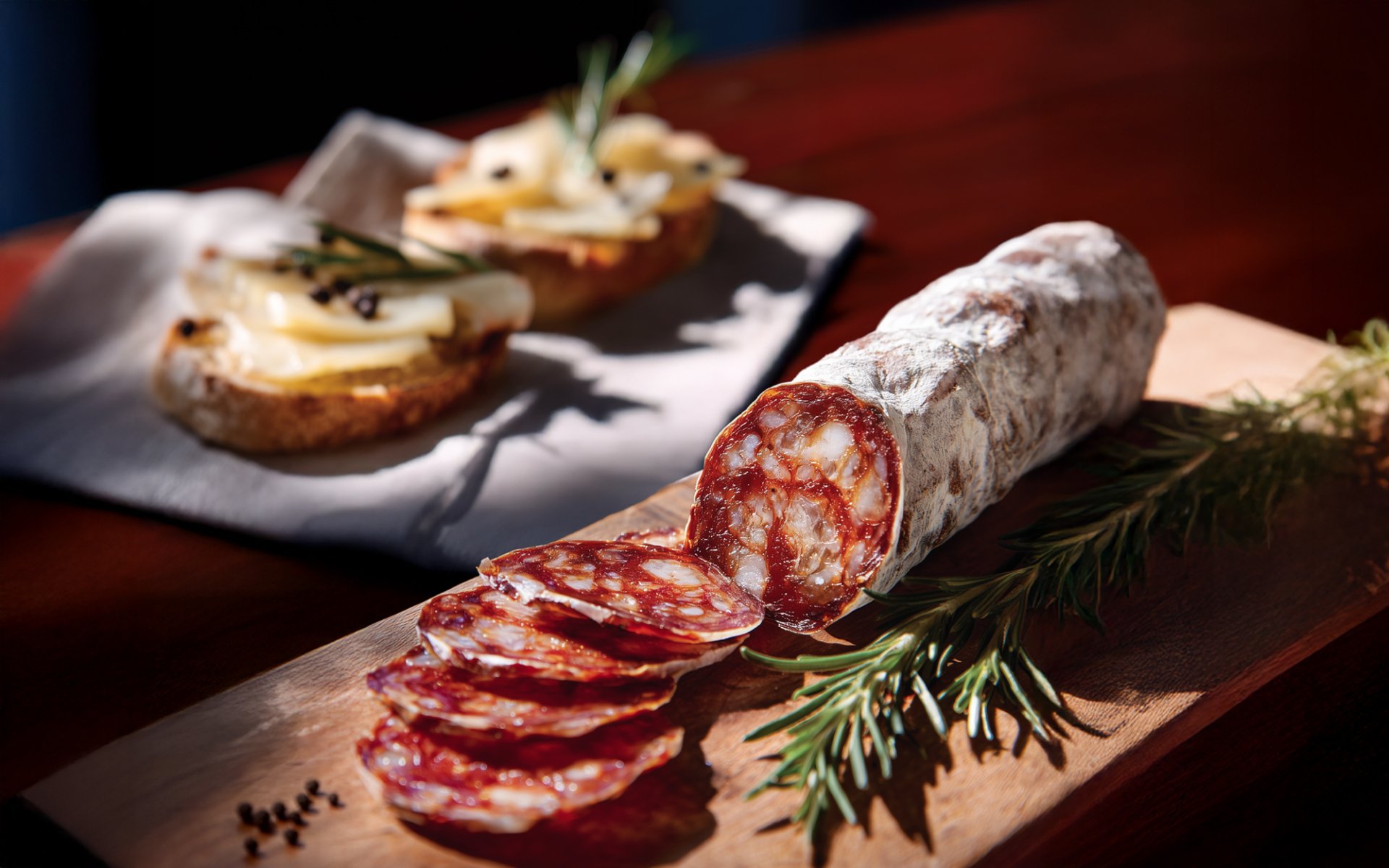Salchichón

Salchichón: The Essence of Spanish Flavor and Craftsmanship
Salchichón is a renowned traditional dry-cured sausage from Spain, widely recognized and popular as an integral part of Spanish culinary culture. This sausage is made from finely minced pork, mixed with a small amount of pork fat or diced bacon. It is then seasoned with salt, garlic, and crucial aromatic ingredients such as black pepper, oregano, and nutmeg (a fragrant spice made from the powdered leaves of the nutmeg tree). After thoroughly mixing the ingredients, the mixture is stuffed into natural pork casings and then dry-cured for approximately 3 months. The addition of pork fat ensures the sausage remains succulent and not too dry or crumbly.
The flavor of Salchichón is delicate and mellow, neither excessively salty nor sweet, and is characterized by the prominent taste and aroma of black pepper.
Meaning of the Name and Distinction from Chorizo
The word Salchichón originates from the Spanish word Salchicha, meaning "sausage," derived from the Latin term salsīcia, which refers to "salting." It is combined with the suffix -ón, a Spanish augmentative used for something larger. Thus, when combined, it signifies "a larger or thicker than usual sausage."
Salchichón is often compared to, or sometimes mistakenly identified as the same as, Chorizo, another traditional dry-cured sausage that many might be more familiar with. While both types of sausages share similarities in their production process and appearance, they have distinct differences:
- Key Ingredients: Chorizo uses paprika as its primary ingredient, giving it its reddish color and pungent flavor, whereas Salchichón uses black pepper, oregano, and nutmeg, resulting in a milder taste.
- Flavor Profile: Chorizo has a bolder and spicier flavor, while Salchichón is milder, emphasizing the aromatic spices.
Beyond these differences in flavor and ingredients, Salchichón also boasts its own fascinating history and story.
Historical Origins and Evolution
Salchichón and Chorizo share a common earliest origin: the sausage-making methods of ancient Greeks and Romans. These food preservation techniques spread to the Iberian Peninsula (which today comprises Spain and Portugal).
Spanish Salchichón and other cured meats are believed to have undergone significant development during the Middle Ages, particularly during the Muslim conquest of the Iberian Peninsula (from 711 AD to around 720 AD). This period saw an intense exchange of culinary cultures among Christians, Jews, and Muslims.
During this time, the production of pork sausages by the Spanish also became a symbol of resistance against the Muslim invasion, as Islamic religious laws prohibit the consumption of pork. Thus, the consumption and production of pork acted as an affirmation of Christian identity and beliefs in Spain.
Regional Varieties and Salchichón de Vic
Salchichón is a significant and widespread food throughout Spain. It can also be made using other types of meat, such as bull, deer, horse, and wild boar. Furthermore, there are numerous regional varieties of Salchichón, reflecting the rich diversity of Spanish culinary culture.
The most famous and oldest variety is Salchichón de Vic, originating from the city of Vic in Barcelona. It was first mentioned in written records from the 14th century and has received PGI (Protected Geographical Indication) certification as a specialty of Vic. The distinctive feature of this Salchichón is the use of meat from the thigh of mature breeding sows, finely minced and mixed with diced bacon. Once stuffed, it is dry-cured for 45 days, relying on the continuous winds blowing from the Montseny Massif mountain range, a crucial factor contributing to its unique flavor and texture.
A finished Salchichón de Vic typically has a straight, cylindrical shape, with a diameter of 7-8 centimeters and a length of 50-60 centimeters. It is commonly enjoyed as Tapas (Spanish bite-sized appetizers) or used as a filling for sandwiches.
This sausage was also a favorite dish of King Alfonso XII, who ruled Spain from 1874 to 1885. A popular anecdote tells that whenever the King had official duties in the Vic region, besides visiting churches and bishops, a mandatory item on his itinerary was a visit to a Salchichón production factory, showcasing his profound affection for this particular sausage.
Other Popular Salchichón Varieties
Other popular and distinctive Salchichón varieties include:
- Salchichón de Aragón: From the Aragon region, notable for its inclusion of pork liver, marjoram (an herb with a fresh, floral aroma), and mace (the aril of the nutmeg seed, with a similar but milder aroma than powdered nutmeg), creating a more complex flavor and aroma.
- Salchichón Cular: From the Basque Country, where the mixture is stuffed into the pig's small intestine (cular) or bovine offal, resulting in a long, approximately 40-centimeter piece with a distinct texture and flavor.
Global Popularity and Cultural Influence
Spaniards consume as much as 61,000 tons of Salchichón annually, only 7,000 tons less than Chorizo. This figure demonstrates Salchichón's immense popularity in Spain and its significant role in daily cuisine.
Spain has also spread its influence in dry-cured sausages and Tapas consumption worldwide through trade, exploration, and cultural exchange. This has contributed to the emergence of various other dry-cured sausages across Europe, such as Salami from Italy or Fuet from France.
Today, Salchichón has become one of the most popular dry-cured sausages globally, standing alongside Chorizo, Salami, and Fuet. This testifies to the unique flavor and rich cultural heritage that this sausage represents.


